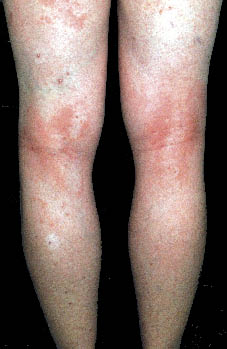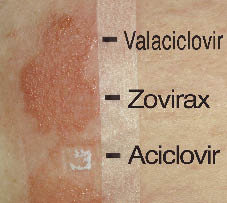Jan Schuster, Mario Fabri, Sabine Eming and Nicolas Hunzelmann
Department of Dermatology, University Clinic of Cologne, Kerpenerstrasse 62, DE-50924 Köln, Germany. E-mail: janschuster@gmx.de
Accepted August 27, 2007.
Jan Schuster, Mario Fabri, Sabine Eming and Nicolas Hunzelmann
Department of Dermatology, University Clinic of Cologne, Kerpenerstrasse 62, DE-50924 Köln, Germany. E-mail: janschuster@gmx.de
Accepted August 27, 2007.
Sir,
Systemic reactions following treatment with intravenous acyclovir are very rare. To our knowledge only a few cases have been reported in the literature, each of them in patients with a history of contact dermatitis to ointments containing acyclovir. We report here a case of a systemic reaction to intravenous acyclovir and discuss alternative treatment options.
CASE REPORT
A 62-year-old woman presented at our department 10 days after returning from a trip to Alaska. Over the previous 7 days she had developed headache, elevated temperature and disseminated erythematous vesicles. The only medication she was taking at this time was L-thyroxine 75 mg once daily for treatment of hypothyroidism. Her skin showed widespread vesicles on an erythematous base without palmar and plantar affection. There was no mucous membrane involvement. The patient was otherwise healthy. A diagnosis of disseminated herpes zoster infection was made subsequently, indicating the need for systemic antiviral treatment. A polymerase chain reaction (PCR) was performed and confirmed varicella zoster infection. According to the patient, she had formerly developed eczema to external acyclovir and external betamethasone. Otherwise, her personal and family history was negative for skin diseases. Due to this medical history of a potential acyclovir sensitization a prick-test was performed, whose results were negative. Given the negative prick results, a test dose of 70 mg acyclovir (1 mg/kg bodyweight), equivalent to 10% of the regular dose, was given intravenously. After 8 h, the patient developed a plain macular erythema with slight infiltration of the popliteal fossae and the trunk (Fig. 1). There was no other medication given at that point. The rash was topically treated with corticosteroids (betamethasone), leading to a complete remission of the exanthema within 2 days. The zoster infection also regressed with out any further treatment or any complications. There was no evidence for neurological involvement at any point. For further diagnostic work-up, we presented the patient to our allergy department, where prick-testing and epicutaneous testing for acyclovir (tablets), valacyclovir (tablets) and a topical preparation (acyclovir, propylene glycol, natrium lauryl) were performed. Patch tests showed a pronounced eczematous reaction (++) at 48, 72 and 96 h for each of the 3 substances. Prick-testing remained negative, as did epicutaneous and prick-testing of corticosteroid series (Fig. 2).
Fig. 1. Erythematous drug eruption of the popliteal fossae.

Fig. 2. Epicutaneous testing on valacyclovir (tablets), the topical preparation Zovirax® (acyclovir, propylene glycol, natrium lauryl) and acyclovir (tablets). The patch test showed an intense positive result (++) at 48, 72 and 96 h for each of the 3 substances.

DISCUSSION
Acyclovir is a guanine analogue antiviral drug, primarily used for the treatment of herpes simplex virus infections (herpes labialis, genital herpes, ocular herpes) and varicella zoster virus infections. Acyclovir is considered a prodrug, which is selectively converted into a monophosphate by viral thymidine kinase. Subsequently, cellular kinases convert the monophosphate form into the active triphosphate form, acyclo-guanosine tri-phosphatase (GTP). Acyclo–GTP is a highly potent inhibitor of viral DNA polymerase. The elimination half-life of acyclovir is approximately 3 h. Most common adverse drug reactions associated with systemic acyclovir therapy include nephrotoxicity and neurological complications. Acyclovir is commonly marketed as tablets, topical cream, intravenous preparations and ophthalmic ointment.
Systemic acyclovir reactions following intravenous application are very rare. To our knowledge, there are only 6 published cases, each of them in patients with a positive history of acyclovir contact dermatitis (1–3). Thus prick-testing, as in our case, is not helpful. Sensitization to topical acyclovir preparations occur much more frequently due to the cream basic components (propylenglycol, natriumlauryl) than to the active agent acyclovir itself (4).
As acyclovir (Zovirax®), valacyclovir (Valtrex®), ganciclovir (Cymeven®) and famciclovir (Famvir®) have a similar chemical structure, of a 2-aminopurine core, cross-reactions exist. Brivudin (Zostex®) is a pyrimidine and therefore has no purine core. Similarly, there is no such core in the non-nucleoside DNA polymerase inhibitors foscarnet (Foscavir®) and cidovir (Vistide®). Hence, it may be possible to use these agents as alternative treatments in patients with known acyclovir contact allergy (5). Accordingly, in epicutaneous testing these substances remained negative in our patient, indicating that these drugs may be safely used. For antibiotics, e.g. penicillin, drug desensitization protocols have proven useful in selected cases (6). Interestingly, there are also 2 reports of successful desensitization to acyclovir. In these 2 cases, the patients displayed only a local allergic rash, but no systemic reactions (7, 8).
In summary, this case illustrates that prior to acyclovir therapy, a history of previous skin reactions to acyclovir-containing preparations should be taken. In case of a positive history and urgent therapeutic need, the use of structurally unrelated compounds, such as brivudin, foscarnet or cidovir, is strongly recommended.
REFERENCES
1. Vernassiere C, Barbaud A, Trechot PH, Weber-Müller F, Schmutz JL. Systemic acyclovir reaction subsequent to acyclovir contact allergy: which systemic antiviral drug should then be used? Contact Derm 2003; 49: 155–157.
2. Carrasco L, Pastor MA, Izquierdo MJ, Farina MC, Martin L, Fortes J, Requena L. Drug eruption secondary to acyclovir with recall phenomenon in a dermatoma previously affected by herpes zoster. Clin Exp Dermatol 2002; 27: 132–134.
3. Lammintausta K, Makela L, Kalimo K. Rapid systemic valaciclovir reaction subsequent to acyclovir contact allergy. Contact Derm 2001; 45: 181.
4. Corazza M, Virgili A, MantovaniL, La Malfa W. Propylene gycol allergy from acyclovir cream with cross-reactivity to hydroxypropyl cellulose in a transdermal estradiol system? Contact Derm 1993; 29: 372–373.
5. Bayrou O, Gaouar H, Leynadier F. Famciclovir as a possible alternative treatment in some cases of allergy to acyclovir. Contact Dermatitis 2000; 42: 42–55.
6. Solensky R. Drug desensitization. Immunol Allergy Clin North Am 2004; 24: 425–443.
7. Kawsar M, Parkin JM, ForsterG. Graded challenge in an aciclovir allergic patient. Sex Transm Inf 2001; 77: 204–205.
8. Henry RE, Wegmann JA, Hartle JE. Succesful oral aciclovir desensitization. Ann Allergy 1993; 70: 386–388.
